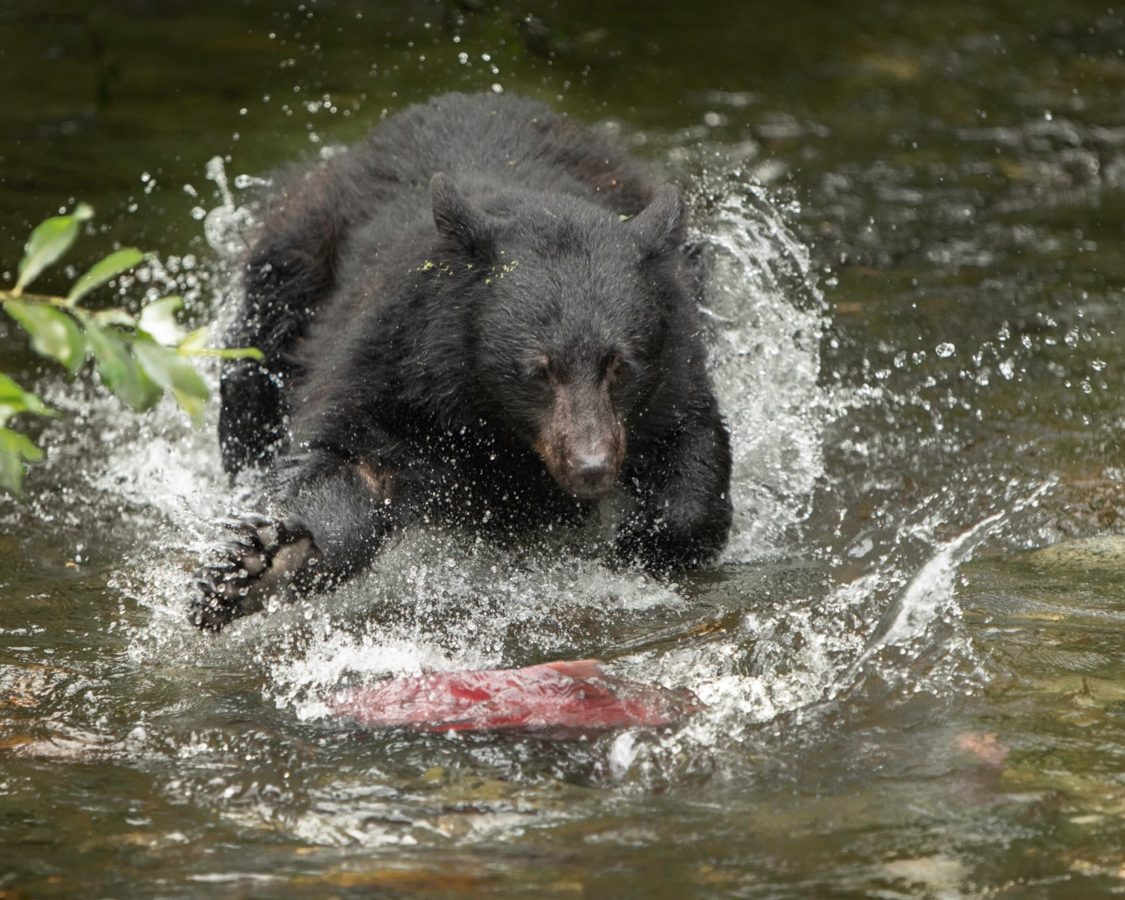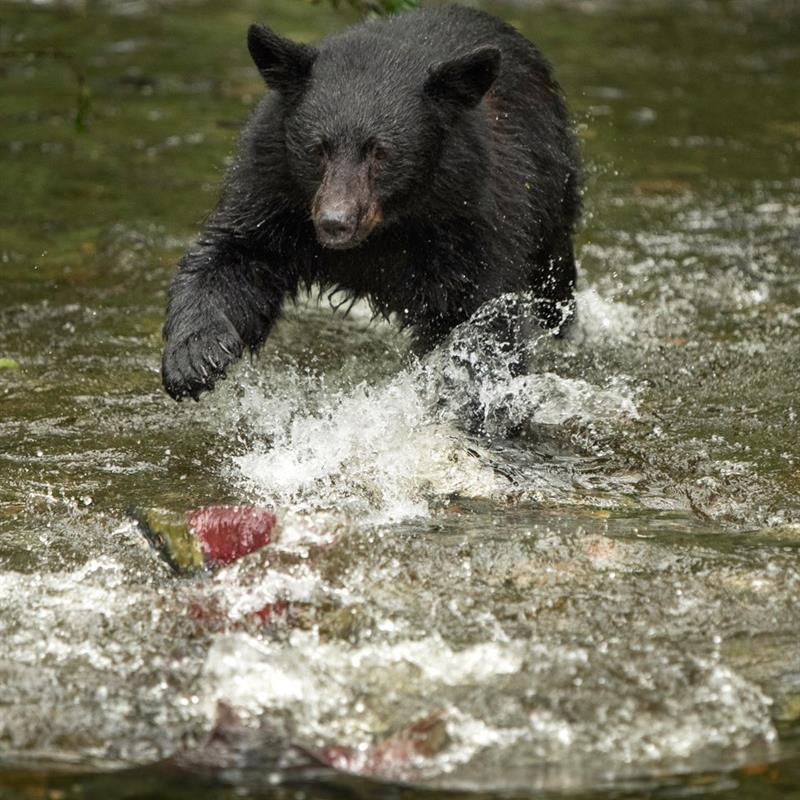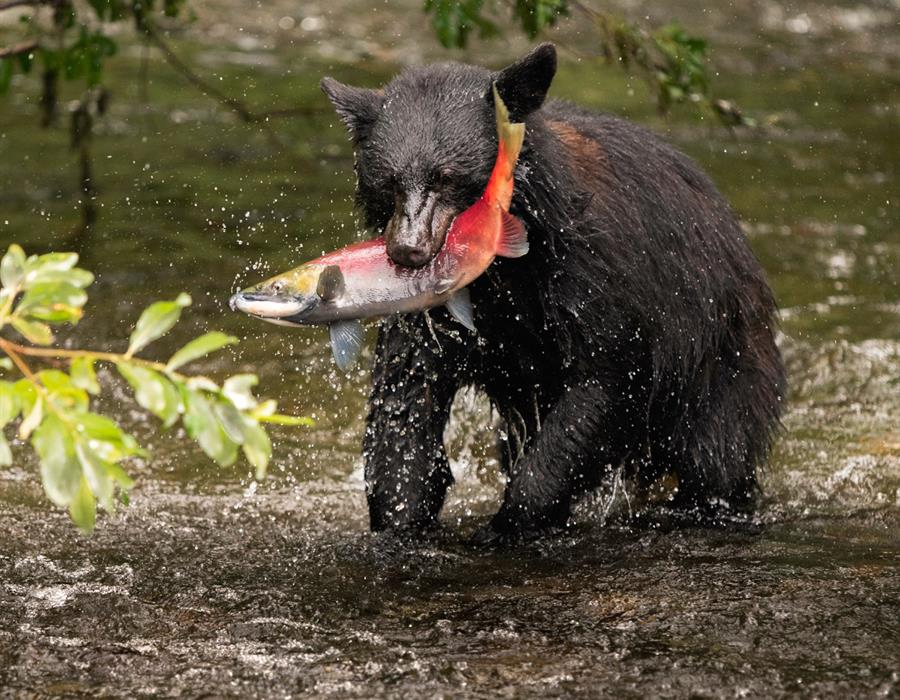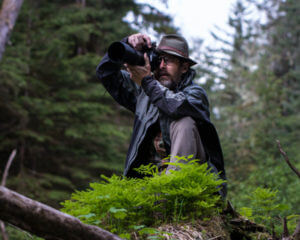Hiking in Bear Country: Smaller Group, Big Difference

We stand on a bridge overlooking Steep Creek in the Mendenhall Glacier Recreation Area on the edge of Tongass National Forest in Juneau, Alaska. Behind us, lost to our view in the dense summer understory, we can hear the crash of Dipper Falls. Beneath and before us, a narrow tongue of fast water flattens into a shallow, sandy-bottomed flow. A dozen sockeye salmon slip side to side, battering their bodies to prepare beds, on which eggs are laid and fertilized.
There are fifteen of us—fourteen guests and me. I am guiding cruise ship passengers on a photo safari that began three hours earlier with a short bus ride to Statter Harbor where we boarded a small, custom whale watching vessel for a couple hours of photographing humpback whales, sea lions, and bald eagles.
Now, we are approaching the mighty Mendenhall Glacier. Along the way we are learning about how the land was sculpted by time, ice, and pressure. The forest here is young. A hundred years ago, the spot where we stand was under the glacier. Now, it is a young forest comprised of mostly Sitka spruce and alder with a few small western hemlocks growing in the shadows. Mosses cover nearly every inch of ground that was bare rock with a little glacial silt when the glacier exposed it.
At this moment, my guests and I are not thinking about the glacier, the primary succession of the forest, or even the salmon at our feet. Though it is not mentioned, we are all focused on one thing: black bears.
Black bears are regular visitors to the area, even more so when salmon are running in the creek, but there is little predicting when they will be where. We cannot expect them.
On the shore, we see piles of scat, and the remains of devoured fish, but there are no bears to be seen. Soon, we will have to continue up the trail. Cruise ships are on a tight schedule, and I have to get them back to the dock on time.
I wait as long as I can, then tell my guests we have to move on. I am leaving some extra time just in case a bear or a porcupine shows up somewhere along the way. One-by-one, the eager photographers raise their lenses from targeted salmon and follow me up the trail. We round a bend in the trail and pause where the understory thins and the broad maple-like devil’s club leaves reflect in pools of water bounded by bright green moss. I allow them to spread out, instructing them to reset their white balance, look for leading lines along the winding trail, and play with their perspective.
After helping a guest with a setting on his camera, I smile at a pair of photographers crouching low to capture a unique angle on a boulder rising from a pool of water. As I watch, I feel my phone vibrate in my vest pocket.
It is another guide, who is doubling as my driver for the day. She tells me there are three bears—a mom and two cubs—crossing the road, headed in the direction of Dipper Bridge.
“Everybody gather up,” I said. “We have a change of plans.”
There is no guarantee we will see these bears, and I do not tell them where we are going, or why we are turning around—only that there is “a change of plans.” Of course, I don’t have to tell them. My guests are able to figure it out, and they waste no time in coming together and excitedly following me back down the trail.

As we round the bend, a handful of tourists without a guide pass us by, headed in the other direction, unaware of what they might be missing.
We arrive at the bridge just as Momma Bear’s nose appears out of the shadows about twenty yards downstream. Fourteen photographers find places to brace cameras on the bridge. Some use the rail, others kneel to look through the slats beneath the rail.
“She’s coming into the light,” I say softly. “Switch back to sunlight mode.” Set your cameras back to shutter priority and at least 1/400 of a second. If you can, go higher. She might lunge after a fish.”
Quick adjustments are made. The bear steps into the light, and surveys the scene. Off her left hip, one of the cubs splashes into the water. The other, crosses behind them in the shadows, climbs onto bank, and begins to whine.
Momma Bear lunges to her right, just missing a fish, then splashes back to her left after another. Salmon are scattering in all directions. After a third lunge, she shakes the water from her thick neck and head like a golden retriever after releasing a duck. The only sound other than the splashing bear and the waterfall, is the rhythmic staccato of camera shutters. The next lunge, hits the mark. She comes up with a shiny sockeye fighting hopelessly against her powerful bite.

She hustles to the bank and disappears into the woods and out of sight. We hear crunching of fresh fish and the whines of cubs, but see nothing. The show is over, and the clock is ticking.
Doubling back, we make it to the overlook where we discuss how to properly expose for a glacier in the sun. Cameras are passed around, classic vacation portraits are taken in front of the giant glacier, and we move on. On the bus ride back to the cruise ship, attention is split between guide and camera backs. When I ask what part of their shore excursion they will remember most, the answers vary. Some say seeing a bear catch a fish was the event of a lifetime. For others, the opportunity to see Mendenhall Glacier before it disappears for good takes the cake. Others, still, were wowed by the whales.
An older couple in the back, looked at me and said, “You, Jim, were the highlight. Thank you for making it all come alive and for teaching us how to use our cameras!”
For me, the highlight of the trip was a vibration in my vest pocket, when my fellow guide had my back, and we worked together to deliver something special for my guests—something I could not have done on my own.
About the Author: Jim Pfitzer is about to begin his second season as a guide for Gastineau, and his second year as an an Alaskan. He was born and raised in Chattanooga, TN, but has moved all over the country pursuing wild places and even wilder experiences. When asked about himself, Jim says he would rather paddle a canoe than drive a car, and prefers watching birds to watching television. “That about sums me up,” he says.


